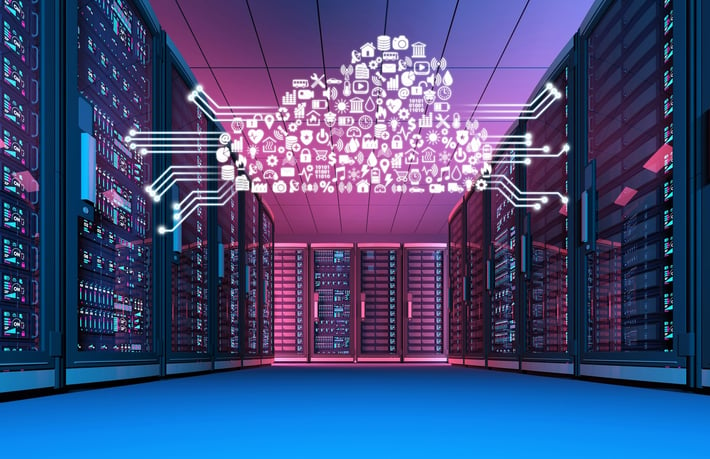
Each week, I engage in discussions around cloud computing. Often I am faced with business owners (many of whom are very successful and experts in their respective fields) who are cloud-averse, meaning they prefer their IT systems to be on premise, living on servers and equipment that they own, rather than “out there” in the cloud. However, once they give me a chance to explain what the cloud is and how it works, they often have a change of heart.
For the past 30 years, businesses have become used to their servers and computers sitting in a room or closet in the same building as the employees. This all started to change around 2000, as companies began to replace their dial-up modems with always-on Internet connections (think T1 and DSL lines). Since businesses were always connected to this new global "Internet" network, providers started designing systems that could be accessed through the Internet, instead of from a company’s private server.
While in theory this made sense, reality at that time presented three big problems:
- First, most of the application providers that started off in the cloud in the first decade of 2000 were startups, and the applications they were building, while nice and shiny, simply didn’t stack up to their “on premise” counterparts in performance, features, and functionality. Businesses wondered what good was a cloud-based system when it didn’t do what the business needed.
- Second, Internet connections in 2000 were not nearly as fast, reliable, or affordable as they are today. Getting online was much slower and more expensive for businesses (in 2002, T1 lines cost $1500+), wi-fi didn’t exist yet, and most homes were still stuck with dial-up.
- Finally, most business owners couldn't grasp the concept of their company’s data being anywhere but within their own space; just like many people were scared of automatic elevators when they first came out (which is why the emergency “stop” button was added shortly thereafter).
Today, in 2017, there are thousands of cloud providers offering hundreds of types of cloud services. While each runs somewhat differently, I can share some behind-the-scenes on how Tabush Group’s private cloud operates. We started building our private cloud in 2003 (before the term “cloud” was coined), and it has been the primary driver of growth in our business ever since.
Location: Our cloud systems live in multiple Tier-3 data centers. These are the equivalent of bank vaults, but for servers. Each building is physically built to much higher standards than a normal commercial building, with fully redundant power and cooling systems. Our primary data center, located near New York City, has been 100% online since opening in 1989. Through all those years, including September 11th, the 2003 blackout, and Superstorm Sandy, it has never gone offline for even a minute.
Security: The data centers are protected by multiple layers of access control and staffed 24x7 with security guards. To get in front of our equipment, our staff need an access card, photo ID, fingerprint ID, and physical interaction with two security guards. As for data security, our network is protected behind multiple ICSA-certified firewalls, we employ 256-bit encryption (just like the banks), and run multiple systems to back up every bit of data we store, several times each day, to separate off-site locations.
Equipment: We use only top-tier hardware from vendors such as Dell, EMC, HP, and Juniper to run our cloud. Because we own and operate everything ourselves, we are constantly adding and upgrading systems to ensure the best performance. Each piece of our cloud infrastructure has numerous redundancies to protect against malfunctions or hardware failure.
Connectivity: We maintain three diverse fiber connections to the Internet with multiple upstream providers. If any one provider or connection has a problem, any affected data is automatically re-routed to another connection within a few seconds using BGP technology (our AS # is 394735).
Maintenance: When somethings in our cloud requires our attention (most often this is a warning which does not affect the performance or our clients) we know about it within a minute or two. Between the 24x7 on-site engineers, the spare hardware and parts that we keep on hand, and the fact that these buildings never close, we are always able to stay ahead of the eight ball.
In short, we’ve built our cloud to be much stronger and more resilient than any small business would for their internal IT systems. After explaining all of this to people (and sometimes taking them on a tour of one of our data centers), if they’re still not convinced, they ask me “What if your cloud goes down?” to which I tell them that what’s much more likely to happen is that their ability to access our cloud may go down (their office loses power or Internet), and if that happens, any systems they have on premise would be down anyway.
Some people are concerned about security and hacking, and understandably so. However, the truth is that as long as a company’s servers or data is connected to the Internet, it doesn’t matter if that data lives on a server in a datacenter, an office, or a basement – it’s still connected to the Internet. A cloud scenario is more secure as the provider performs better protection and backups than the business would on their own.
So that’s what the cloud is. Today, in 2017, everything has changed from 2000. Cloud software has matured and often is more reliable and more functional than its non-cloud alternative. Internet connectivity is super-fast, affordable, reliable, and available just about everywhere on the planet. And how we do so many things has changed, from commuting via Uber, staying in an Airbnb, watching movies on Netflix, and getting music on Spotify.
The cloud, for the most part, is more secure than on premise. It’s often more cost effective. When done right, it’s more reliable and more functional too. Every business owner owes it to their company to take a serious look at what cloud options are available for their industry.
This is also why we developed Boxtop, which includes virtual desktops in our private cloud environment. To learn more, I encourage you to watch one of our videos and/or on-demand webinars.








